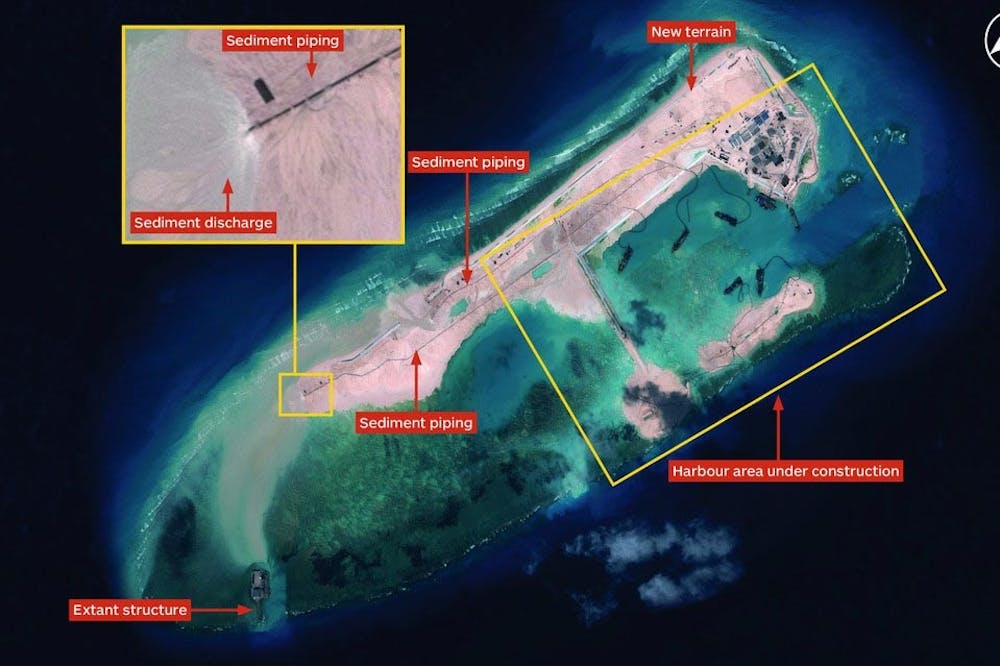By Joe Friedrichsen | Echo

In the Spratly Island chain, the Dragon is undertaking a controversial new project to reassert its long-lost dominance in the South China Sea.
China's neighbors are perturbed by China's aggressive land reclamation efforts. They fear the moves are another step toward the rapidly growing nation becoming a regional bully.
For China, its recent island transformation efforts are only the latest in a series of belligerent moves in the area. After a three-month standoff with the Philippine Coast Guard in 2012, China seized the Scarborough Shoal (an area also claimed by Taiwan). Beijing also placed an oil rig near the disputed Paracels (an archipelago claimed by Vietnam, China and Taiwan) last year, sparking violent anti-China riots in Vietnam, CNN reported.
Behind these moves is China's sweeping assertion that it owns 90 percent of the South China Sea within a giant loop known as the "nine-dash line." Though the land lies far from its borders, the Dragon argues that its fishermen held island chains like the Spratlys and Paracels more than 2,000 years ago.
But China isn't alone in staking its territorial claims on historical grounds. Vietnam points to its rule of the islands in the 17th century as justification for its claim, according to an article by the American University International Law Review.
What's the point of China claiming the Spratly Islands? According to the U.S. Energy Information Agency (EIA), the South China Sea is one of the most important energy trade routes in the world. Nearly a third of global crude oil and over half of global liquefied natural gas (LNG) passes through the South China Sea each year.
The sea and its islands are also important because they strategically lie between several Asian countries. Having a military presence there could allow China to project its power across the region and stunt other countries' abilities to do the same.
In the South China Sea, the EIA estimates there being around 11 billion barrels of oil and 190 trillion cubic feet of natural gas in proven and probable reserves.
Because access to water and other natural resources depends on the distance from a country's coastline, China's claim to ownership of islands can potentially allow it to claim resources in the waters around the islands as well, according to the United Nations Convention on the Law of the Sea (UNCLOS).
That's where the legal controversy begins. As Beijing points out, international law (UNCLOS) permits land reclamation activities.
In fact, Malaysia and Vietnam have used land reclamation themselves. But the Philippines is challenging China on the wider territorial dispute over the definition of what an island is. Why is this legal challenge significant?
Under UNCLOS, islands have significantly more territorial rights than do low-tide elevations like rocks, reefs and shoals. Island holders gain what's called an Exclusive Economic Zone. These zones give significant rights that include exclusive access to energy exploration and exploitation.

In its argument, the Philippines claims China is developing land that are rocks and low-tide elevations-an argument China rejects, according to the Asia Maritime Transparency Initiative (AMTI).
As Gregory Poling, a fellow at the Center for Strategic and International Studies, points out, this island vs. rocks distinction matters for China because geographical surveys in the South China Sea have traditionally been poor. For China, then, the more and faster it builds and expands these islands, the harder it becomes for others to determine what the land originally was, thus preventing the U.N. from ruling its "island" claims illegitimate.
But bolstered by what it sees as its legal safety net, China is expanding its military presence on several "islands" it controls. Aerial photographs from AMTI suggest an airstrip under construction on Fiery Cross Reef.
On the significantly expanded Gaven Reef, satellite photographs reveal a helipad and new anti-aircraft tower installed for defense.
Explaining the Chinese military and infrastructural buildup, AMTI said China sees itself playing catch up with the other four countries (Vietnam, the Philippines, Malaysia and Brunei) already occupying and claiming what China believes to be its Spratly territory.
Such competing claims have led to violence before and certainly could again. China's increasingly assertive behavior in the volatile South China Sea could bring it into conflict with the Philippines-a strong U.S. ally. And that's why the resurgent Dragon must be careful.





